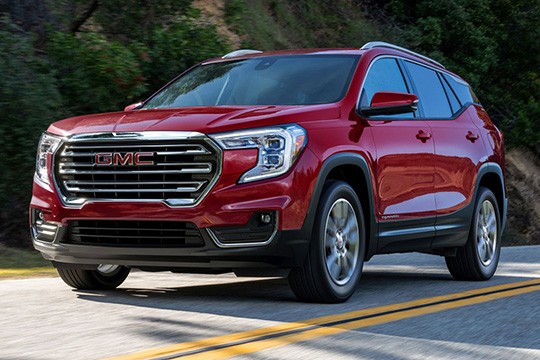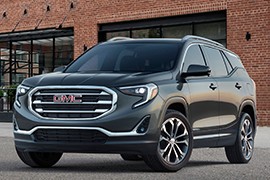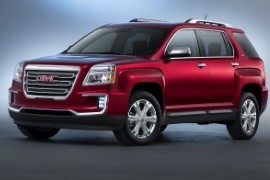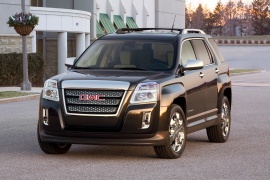GMC Terrain Models/Series Timeline, Specifications & Photos
First production year: 2009
Engines: Gasoline, Diesel
Body style: SUV (Sports Utility Vehicle)
GMC refreshed the second generation of the Terrain SUV in 2021 for the 2022 model-year and gave it some restyled lines and turbocharged engines.
After four years since the introduction of Terrain's second generation, GMC came with a mid-life cycle refresh for its compact SUV. The new version brought the AT trim level, which was focused more on off-road abilities. Even though the Terrain was not an off-road vehicle, it could handle some rough areas, mud, and snow.
On the outside, the 2021 Terrain showed a different front fascia, with taller headlights and C-shaped daytime running lights. Its twin LED headlamps were stacked one on top of the other. While the rest of the bodywork remained the same as its predecessor, including the taillights, GMC introduced four new colors.
Inside, GMC enhanced the infotainment system and included the wireless Apple CarPlay and Android Auto as a standard feature for the entire range. For the Denali trim level, GMC had an 8" infotainment as part of the package. Another useful feature was the head-up display, which became available as an option for the SLT and AT4 versions and standard on the Denali.
Under the hood, GMC kept most of its previous engines and added an inline-four turbocharged gasoline engine paired to a nine-speed automatic transmission. Its state-of-the-art direct-injected system and variable valve timing made it very fuel-efficient.
Built on the same platform with the Buick Envision and the Chevrolet Equinox, the 2018 GMC Terrain was a good answer for economical and affordable SUVs.
The SUV market was growing fast and most car-makers tried to increase their offers in the segment. GM flexed its muscles and developed a new platform for the compact SUV market. The new styling was backed-up by the new technologies involved in the project.
The floating-roof design of the Terrain was a big improvement for the GM design team. While some of the previous SUVs made by GMC were trapped in a conservative design language, the Terrain looked like it was started from a blank sheet of paper, and with a new team. The car was tested in the wind-tunnel to offer a lower drag coefficient. The signature-LED for the daytime running lights, the big grille that looked like a chained-fence and the massive GMC letter in the middle, the Terrain offered a strong and powerful appearance.
Inside, the passengers were delighted by a big interior, obtained due to the transverse engines and the 2.72 m (107.3”) wheelbase. There were more trim levels and a big options list. For the 2018 model, GM offered a standard 7” infotainment display on top of the center stack. The gear-stick was removed and a rotary-knob selector was chosen.
For the engine compartment, the Terrain was offered exclusively with turbocharged 4-cylinder units. The smallest one was 1.5-liter gasoline. There was an option for a more powerful 2.0-liter turbocharged unit with the same fuel. The most important addition was the 1.6-liter turbodiesel unit, which offered good power and a lot of torque.
GMC updated the second generation of the Terrain lineup in 2015 for the 2016 model year, improving one of its best-selling models on the market.
With a growing demand for SUVs, it was no wonder that GMC, as one of the most important SUV manufacturers, had a huge success with the Terrain lineup. Initially launched in 2010 as a replacement for the Pontiac Torrent, which was axed along with the entire brand, it managed to sell more than 100,000 units in a year. But the carmaker didn't rest on its laurels and pushed harder to keep the momentum.
In 2016, the Terrain received a well-deserved update. At the front, the car received a new pair of headlights with a sharper design, while the grille was taller. Furthermore, the hood received a new power dome design. In addition, the automaker added a set of LED fog lamps in the bumper, replacing the former halogen-based ones. At the back, the bumper got new styling, with an extended chromed trim at the lower side.
Inside, the most striking difference was on the center stack, which got a completely new design, along with an improved infotainment unit. There were also new colors for the interior, including a saddle-brown that was much appreciated by the customers. Last but not least, the 2016 Terrain received chromed trims around the shifter, which was previously available only on the Terrain Denali version.
But the most significant change was under the hood. While the base engine was the same 2.4-liter inline-four, the V6 version was enlarged from 3.0 to 3.6-liter displacement. The manual transmission option was deleted, and GM offered only a six-speed automatic gearbox. Like its predecessor, the 2016 Terrain was available in front-wheel drive or all-wheel drive configuration.
GMC introduced a new SUV in its lineup in 2009 as a 2010 model based on the same Theta platform as the Chevrolet Equinox and the luxurious Cadillac SRX.
Despite the world's financial crisis and the difficulties met by GM in Europe, the carmaker didn't want to give up on its hopes of ruling the SUV segment. The Terrain was a family-oriented vehicle with room for five, an angular design, and fuel-efficient engines.
GMC offered the Terrain a bold design with a chromed surrounding for the grille and squared corner-mounted headlights. On the lower sides of the bumper, the crossover SUVsported vertical lamps, creating the image of an even taller vehicle than it actually was. On the sides, the wheel arches were widened in angular shapes, emphasizing the off-road abilities. But it was more show than go since it wasn't really prepared to tackle trails and uncharted maps through the forest.
Inside, the silver-look of the interior trims looked impressive, but they were actually made from plastic. On the center stack, GM installed its newest infotainment unit with a seven-inch touch-screen placed on top. The On-Star and XM Radio were standard on the entire range.
Under the hood, GM opted for a 2.4-liter inline-four for the base model and a 3.0-liter V6 for those who didn't really care about the hiking price of the gas. Moreover, to provide lower fuel consumption figures, GM offered the Terrain with a front or an all-wheel-drive system.



